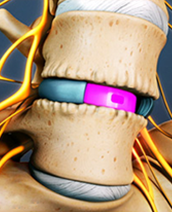
Anterior Lumbar
Interbody Fusion
The anterior lumbar interbody fusion (ALIF) is similar to the posterior lumbar interbody fusion (PLIF), except that in the ALIF, the disc space is fused by approaching the spine through the abdomen instead of through the lower back. In the ALIF approach, a three-inch to five-inch incision is made on the left side of the abdomen and the abdominal muscles are retracted to the side.
Since the anterior abdominal muscle in the midline (rectus abdominis) runs vertically, it does not need to be cut and easily retracts to the side. The abdominal contents lay inside a large sack (peritoneum) that can also be retracted, thus allowing the spine surgeon access to the front of the spine without actually entering the abdomen.
There is also a less popular transperitoneal approach that accesses the spine through the abdomen. This adds a lot of unnecessary morbidity to the procedure and therefore is used much less often.
Although previously there was a lot of interest in perfecting an endoscopic approach for ALIF surgery, it has largely been abandoned because it placed the great vessels (aorta and vena cava) at too great a risk.
These large blood vessels that continue to the legs lay on top of the spine, so many spine surgeons will perform this surgery in conjunction with a vascular surgeon who mobilizes the large blood vessels. After the blood vessels have been moved aside, the disc material is removed, and bone graft, or bone graft and anterior interbody cages, is inserted.
Advantages
The ALIF approach is advantageous in that, unlike the PLIF and posterolateral gutter approaches, both the back muscles and nerves remain undisturbed.
Another advantage is that placing the bone graft in the front of the spine places it in compression, and bone in compression tends to fuse better. Lastly, a much larger implant can be inserted through an anterior approach, and this provides for better initial stability of the fusion construct.

